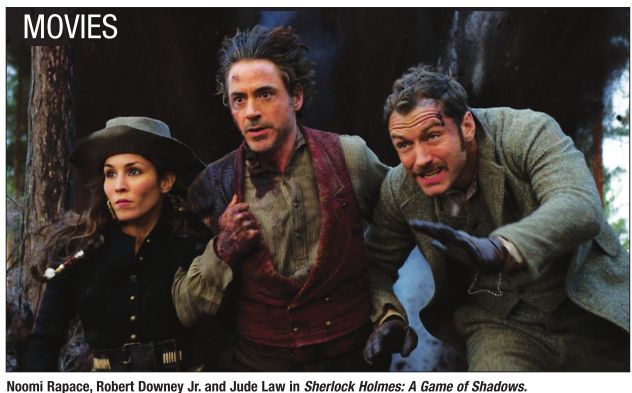
Briskly executed, genuinely exciting and altogether entertaining, Sherlock Holmes: A Game of Shadows, manages to outdo its predecessor by keeping all that was right about that film – the chemistry between its two leads, the sumptuous recreation of England’s late Victorian Age and an inventive approach to action – and provide what that 2009 feature was lacking. That would be the addition of a worthy adversary for the famous detective. Screenwriters Michele and Kieran Mulroney pluck Holmes’ greatest enemy, Dr. Moriarty, from Sir Arthur Conan Doyle’s original novels and build a smart, complex and altogether nefarious plot around him.
The result is a rip-roaring, edge-of-your-seat adventure that outdoes most of the thrillers that have graced the screen this year.
The game is already afoot as the film begins, with Holmes (Robert Downey, Jr.) in hot pursuit of Irene Adler (Rachel McAdams), his love interest from the first film, who’s intent on delivering a mysterious package to a groundbreaking surgeon at an auction house. The detective does manage to thwart her, but not before having to dispatch four thugs with his trademark analytical and prescient approach to self-defense.
Though it moves quickly, the film’s plot is easy enough to follow. It spends equal time on two effective plotlines. The first is played for laughs and ultimately a bit of poignancy as the relationship between Holmes and Dr. Watson (Jude Law) is developed further here and provides us with a more solid foundation for the loyalty they feel towards each other. All the good doctor wants to do is take his new bride (Kelly Reilly) on their honeymoon, an event that’s thwarted by the machinations of his friend’s enemy. Moriarity’s scheme is to form his own industrial-military complex by facilitating the start of a world war with a timely assassination at a summit of world leaders. Seems he’s been buying up munitions factories, so the conflict would more than adequately line his pockets.
The balance director Guy Ritchie employs here should be followed by anyone setting out to make an adventure of this sort. He eschews the notion that wall-to-wall action is necessary to deliver adequate thrills and devotes amble time to developing his characters. Holmes is quite manic at the beginning of the film, knocked back on his heels by Watson’s impending nuptials and unraveling Moriarty’s plot. Downey’s firmly in his element here, with his hurried dialogue and manic movements, while conveying a sense of poignancy in this genius whose intelligence is as much of a curse as it is a blessing. Law has the unenviable task of trying not to be blown off the screen by his co-star’s showy turn. He succeeds by knowing when to hold back and when to take advantage of Watson’s prime moments without trying to compete with Downey.
To be sure, the script is a bit overstuffed. A subplot involving a band of gypsies, led by the fetching Madam Simza, seems forced and comes off as an excuse to give the film a more international flavor by including Noomi Rapace of Dragon Tattoo fame. The scenes between her character and Holmes are intriguing and it seems as though Ritchie and the Mulroneys may have missed the boat in not developing it further.
The production design by Sarah Greenwood manages to create a genuine sense of place, a grimy world that is a reflection of Holmes’ character. The era has one step in the past and the other in the future. Horses and automobiles share London’s streets while modern industry is taking a foothold, as are innovations such as the subway, all of them signaling the coming of the 20th century. Holmes is in a similar situation, far ahead of his time, yet stuck in a world that constantly lags behind him.
The film features one of the most exciting action sequences of the year, as Holmes, Watson and Simza flee through a forest while being bombarded by heavy artillery. This is an intelligent mystery with a healthy dose of laughs and thrills. Game of Shadows provides a worthy foundation for what we hope will be a long line of quality films.